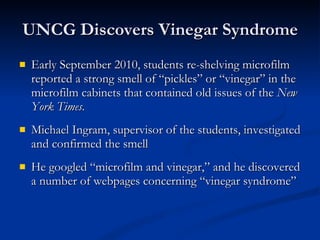The Vinegar Syndrome
- 1. The Vinegar Syndrome A Death Threat to the Microfilm Collection Stephen Dew Collections & Scholarly Resources Coordinator UNCG Libraries
- 2. Microfilm Made with Two Layers Liverpool optician Benjamin Dancer developed the process for microfilm in 1852 The emulsion layer is the layer that actually contains the image. This side has a matte -like appearance The base layer is the transparent, supporting layer to which the emulsion layer is adhered Essentially the same process later used for microfilm, motion picture film, and reel-to-reel audio film
- 3. Nitrate Microfilm, 1920-1930s For early microfilm, the base layer was made of cellulose nitrate Unfortunately, cellulose nitrate proved to be unstable, and in the presence of moisture, heat, and acids, strands of cellulose nitrate tend to become detached, liberating nitro groups ( one or more groups of NO 2 ions) Nitro groups are harmful substances; they are strongly acidic and strongly oxidizing in nature. Nitrate film, especially if deteriorating, is a fire hazard
- 4. Acetate Microfilm, 1923-1980s Cellulose triacetate was used as the base layer for microfilm between 1923 and 1980s Acetate film was originally thought to be highly stable Since it could not degenerate to form nitro groups, it was termed “safety film” Transition from nitrate to acetate film lasted from 1930 to 1950 Unfortunately, acetate film proved to be just as unstable as nitrate, but not as toxic
- 5. Polyester Microfilm, 1970-Present Most current microfilm uses polyester for the base layer Polyester if very stable and has a 500 year expected lifespan Nitrate & Acetate film have a 100 year lifespan
- 6. Vinegar Syndrome Vinegar syndrome is a slow form of chemical decay that causes cellulose acetate film base to shrink, warp, curl, and become brittle. Long strands of cellulose triacetate react with water to form cellulose diacetate and acetic acid Vinegar is a 5% solution of acetic acid in water, and acetic acid is what gives vinegar its smell This decay is inevitable .
- 7. Ã˝
- 8. Ã˝
- 9. Ã˝
- 10. Ã˝
- 11. Acetic Acid Speeds Up Degeneration Cellulose triacetate microfilm is prone to degenerate and is especially sensitive to temperature and humidity Acetic acid is a product of the reaction of acetate and water Acetic acid is a catalyst for the reaction, speeding up the degeneration process Eventually, the process feeds on itself and becomes “autocatalytic”
- 12. Ã˝
- 13. UNCG Discovers Vinegar Syndrome Early September 2010, students re-shelving microfilm reported a strong smell of “pickles” or “vinegar” in the microfilm cabinets that contained old issues of the New York Times . Michael Ingram, supervisor of the students, investigated and confirmed the smell He googled “microfilm and vinegar,” and he discovered a number of webpages concerning “vinegar syndrome”
- 14. UNCG Discovers Vinegar Syndrome Ingram discovered Website for the Image Performance Institute (IPI), producer of “A-D Strips: Film Base Deterioration Monitors” Ingram informed, the Head of Reference, the Collections Coordinator, and the Assistant Dean for Collections & Technical Services They approved the purchase of A-D Strips for testing individual rolls of microfilm (250 strips per package for $60)
- 15. UNCG Discovers Vinegar Syndrome Late September 2011, testing process began on New York Times , 1930-1940, where the smell was strong Students discovered the vinegar smell in other cabinets, and testing expanded to the Greensboro Daily Record , the Raleigh News & Observer , and the Carolinian Testing process was slow, taking about 50 rolls at a time for each title and focusing on 1920-1980 By July 2011, about 1,000 rolls had tested positive
- 16. Ã˝
- 17. Acetic Acid as Irritant Dilute concentrations of acetic acid are safe. vinegar contains about five percent (5%) by mass and this is generally harmless. At higher concentrations, at least ten percent (10%), acetic acid becomes an irritant. It can be an eye irritant, inducing secretion of tears, and it can be a skin irritant, causing discoloration and itching
- 18. Ã˝
- 19. Ã˝
- 20. Limited Storage Conditions at UNCG Jackson Library Basement, 73 F, 43% RH Ferguson Remote Storage, 69 F, 39% RH
- 21. Ã˝
- 22. Ã˝
- 23. Ã˝
- 24. Ã˝
- 25. Ã˝
- 26. Ã˝
- 27. Rolls Replaced, Stored, & Discarded Carolinian rolls have been replaced and will be digitized (digitization project) New York Times, since available online, rolls are being withdrawn and discarded Greensboro Daily News and Raleigh News & Observer Stages 1 and 2 going to storage, stage 3 discarded Patrons referred to Greensboro Public Library Replacements will be $12/roll from State Library
- 28. Vinegar Syndrome at UNCG Testing will continue on NYT and RN&O With large collection of cellulose triacetate microfilm and less-than-ideal storage, UNCG can expect to discover more rolls and titles affected by the vinegar syndrome
- 29. If you own Triacetate Microfilm This Is a Warning!
- 30. The Vinegar Syndrome Is Inevitable And It Will Be Visiting a Library Near You -- SOON






























